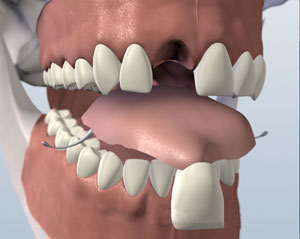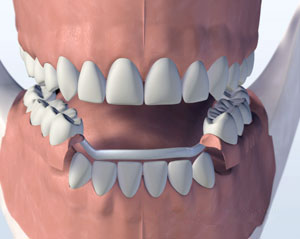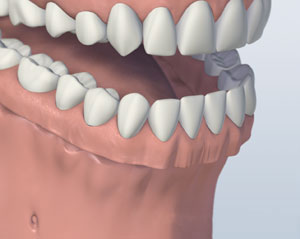Tooth Replacement in St. Augustine, FL
Missing teeth affect more than just your smile – they can impact everything from your ability to chew and speak to your long-term oral health. A single tooth loss may seem minor at first, but it can shift your bite, create pressure on remaining teeth, and even lead to gum disease or jaw deterioration.
Who would want their appearance and health to deteriorate? That’s the natural consequence of missing teeth – the jaw literally melts away. Generally, people will lose 25% of their supporting jawbone structure within the first year after tooth loss. Dental implants are more easily placed when teeth are first extracted because bone replacement becomes more complex as time passes. The great news? Implants act just like your natural teeth. They safeguard and preserve your bone structure, oral health and appearance. Your dentist and the implant surgeon will provide you with options so that you can make the most informed decision concerning tooth replacement.
Why Prompt Tooth Replacement Matters
When you lose a tooth, the surrounding bone and gum tissue begin to recede. In fact, within the first year after losing a tooth, you may lose up to 25% of the supporting jawbone in that area. This bone loss can compromise adjacent teeth, impact facial structure, and limit future treatment options if left unaddressed.
Dental implants offer a solution that mimics natural teeth – from their function to their appearance. Acting as artificial tooth roots, implants stimulate the bone and prevent the deterioration that typically follows tooth loss. Early implant placement after teeth are extracted often reduces the need for additional procedures like bone grafting.
Dental Implants – A Permanent, Natural-Looking Solution
Dental implants are designed to restore both the function and feel of natural teeth. The titanium post of the implant fuses with your jawbone, creating a durable foundation for an artificial tooth, bridge, or denture. This makes them ideal for single tooth replacement or for replacing multiple missing teeth with an implant-supported prosthesis.
Unlike traditional dentures or bridges, dental implants don’t rely on adjacent teeth for support. This helps preserve the health of your remaining teeth and reduces the risk of damage or decay. For many patients, this implant technology provides a lifetime solution with proper care and maintenance.
Implant Placement and Candidacy
Successful implant placement depends on a few factors, including jawbone density, overall oral health, and medical history. Your dental specialist will conduct X-rays and possibly 3D imaging to evaluate your bone structure and determine if any preparatory procedures like bone grafting or sinus lifts are needed.
Patients with chronic conditions like diabetes, smokers, or those who’ve undergone radiation therapy near the jaw may face a slightly reduced success rate. However, advances in implant technology and surgical planning continue to expand eligibility for more patients than ever before.
Tooth Replacement Options
While dental implants are the gold standard, other tooth replacement options may be suitable depending on your condition and goals. A traditional fixed bridge uses adjacent teeth as anchors to hold a replacement tooth in place. While effective, this option requires altering healthy teeth and doesn’t prevent bone loss in the area of the missing tooth.
A removable partial denture is another alternative, especially when multiple teeth are missing. It typically consists of a metal and acrylic base that clasps onto existing teeth for support. Although more durable than plastic alternatives like flippers, a removable partial denture may still require periodic adjustments and does not engage the bone like an implant.
If you’re missing several or all of your teeth in the upper jaw or lower jaw, options like a full removable denture or an implant-supported denture may be recommended. A removable denture is often a cost-effective choice, but it can feel loose or uncomfortable for some, especially as gum tissue changes over time.
Implant-supported dentures offer a secure and natural-feeling upgrade. With only a few implants placed strategically in the jaw, they can support dentures firmly and eliminate common issues like slipping, clicking, or dietary restrictions. Patients often report feeling more confident and comfortable with these modern solutions.

Fixed Bridge
A fixed bridge is a connected set of replacement teeth. For support, it is cemented into position on top of the teeth adjacent to the empty space. The protective outer layer of these teeth is usually removed or ground down prior to attaching the bridge.

Flipper
A fragile, temporary and inexpensive solution is a removable plastic tooth with a plastic retainer, often called a “flipper”.

Metal Partial
A less fragile option is a removable partial denture cast in metal and plastic. It is held in place by wire clips. A removable partial denture can be removed and reinserted when required by the patient.

Denture
The most common solution, for people missing all teeth in one or both jaws are complete dentures. Some people adapt well to dentures. Others find them uncomfortable, even intolerable, because of differences in jaw size and shape.

Dental Implants
Dental implants are the most comfortable and permanent solution. They form a strong foundation for teeth and keep the jaw healthy and strong. Implants support individual replacement teeth or secure specialized dentures in place. Unlike bridges, no healthy teeth are damaged. Unlike most bridges, implants can last a lifetime. Implant-supported replacement teeth can be attractive, stable, and comfortable for almost any patient.
The Role of Oral Health and Professional Care
Regardless of which option you choose to replace missing teeth, maintaining good oral health is key to long-term success. Conditions like gum disease must be managed before tooth replacement to ensure the stability of the implants or dentures. Your dental specialist will work closely with you to create a treatment plan that promotes healing, function, and esthetics.
Working with an experienced provider, such as an oral surgeon or a dentist with advanced dental school training, ensures precision in implant placement, integration, and restoration. From consultation to final fitting, your care team will focus on preserving your remaining teeth, supporting healthy gum tissue, and restoring a smile that looks and feels natural.
Choosing the Right Tooth Replacement Plan
Understanding how many teeth you need to replace, the condition of your existing teeth, and your personal preferences will help guide your decision. For a single tooth or a damaged tooth that needs removal, an implant is often the best long-term solution. For multiple teeth or full arch replacement, a combination of implant technology and prosthetics can deliver both function and aesthetics.
Whether you’re considering a partial denture, full removable denture, or dental implants, the goal is the same – to restore your oral health, protect adjacent teeth, and improve your overall quality of life. Let a qualified dental specialist in St. Augustine help you explore your options and reclaim your smile with confidence.